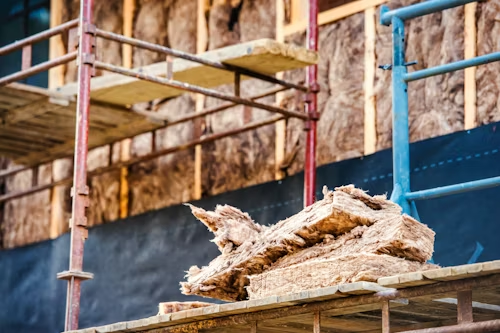Asbestlint, often referred to in discussions surrounding construction and safety, may not be a household name. Yet, it carries significant implications for anyone involved in building or renovating properties. This seemingly innocuous material has roots deep in the history of construction due to its durability and heat-resistant properties. However, with that legacy comes serious concerns about health risks associated with exposure.
As we delve into the world of asbestlint, we’ll explore its common uses throughout history and why it’s become a focal point for safety regulations today. Understanding this material is crucial—not just for industry professionals but also for homeowners and renovators looking to protect themselves from potential hazards lurking within older structures. Let’s uncover what you need to know so you’re informed and prepared when dealing with asbestlint in any context.
The History of Asbestlint and its Common Uses
Asbestlint, commonly known as asbestos tape, has a storied past intertwined with the construction industry. Initially hailed for its durability and heat resistance, it became a staple in various applications throughout the 20th century.
Builders often used asbestlint for insulation around pipes and ducts. Its ability to withstand high temperatures made it ideal for protecting structures from fire hazards.
In addition to insulation, contractors utilized asbestlint in roofing materials and floor tiles. The product was inexpensive and readily available, making it an attractive choice during periods of rapid industrial growth.
Unfortunately, the very properties that made asbestlint desirable also contributed to significant health risks later discovered by researchers. As awareness grew about these dangers, many countries began reevaluating its use across all industries.
The Dangers of Asbestlint in Construction Materials
Asbestlint poses serious health risks, especially in construction materials. This mineral fiber can easily become airborne when disturbed, leading to inhalation.
Once inside the lungs, asbestos fibers may cause severe respiratory issues. Diseases like asbestosis and mesothelioma are directly linked to exposure. These conditions often develop years after initial contact.
Even brief exposures can be harmful. Workers demolishing or renovating older buildings must take precautions against this hidden threat.
Moreover, the danger isn’t limited to construction zones. Asbestos particles can linger in dust; they might even travel home on clothing.
It’s essential for both workers and homeowners to understand these risks as we navigate a world filled with aging infrastructure containing potential hazards like asbestlint. Awareness is critical for prevention efforts and ensuring safety at every project stage.
Regulations and Guidelines for Handling Asbestlint
Regulations surrounding asbestlin are stringent due to its hazardous nature. Various governmental bodies enforce strict guidelines for its safe handling and removal.
In many countries, only licensed professionals can manage asbestos-related tasks. This ensures that all safety protocols are followed meticulously.
Workers must undergo specific training to recognize and deal with asbestlin safely. Personal protective equipment (PPE) is essential during any work involving this material.
Proper containment methods are required to prevent the release of fibers into the air. Wetting down materials before removal helps minimize dust generation.
Disposal regulations dictate how asbestlin waste should be handled. It often requires special facilities designed for hazardous materials, ensuring it does not pose a risk to public health or the environment.
Compliance with these regulations is crucial for protecting workers and communities from potential exposure risks associated with asbestlin in construction settings.
Alternatives to Asbestlint in Modern Construction
The construction industry has evolved significantly, paving the way for safer alternatives to asbestlint. Materials like fiberglass and mineral wool insulation have gained popularity due to their excellent thermal properties without the associated health risks of asbestos.
Another promising substitute is cellulose insulation, derived from recycled paper. Not only is it eco-friendly, but it also provides effective soundproofing and fire resistance.
For roofing applications, thermoplastic polyolefin (TPO) membranes are a great choice. They’re lightweight, durable, and don’t pose the same hazards as traditional materials containing asbestos.
Additionally, modern sealants and adhesives made from non-toxic substances are now widely available. These products ensure strong bonds while keeping indoor air quality safe for occupants.
Innovative building practices continue to emerge that prioritize sustainability and safety—showing that we can construct efficiently without compromising human health or environmental integrity.
How to Identify and Handle Asbestlint in Older Buildings
Identifying asbestlint in older buildings requires a careful approach. Start with visual inspections. Look for textured surfaces, especially around pipes and ducts, where this material might be hiding.
Pay attention to any peeling or damaged areas of insulation, flooring tiles, or ceiling panels. These can indicate the presence of asbestlint.
If you suspect its existence, avoid disturbing these materials. Disturbance can release fibers into the air, increasing health risks significantly.
It’s wise to engage professionals trained in asbestos management for testing and removal. They have the tools and expertise needed to assess whether asbestlint is present safely.
Always prioritize safety by wearing protective gear if you’re involved in renovations or repairs near suspected areas. Awareness is key when dealing with potentially hazardous materials like asbestlint; being informed helps protect both your health and that of others around you.
Conclusion: Taking Steps to Protect Against Asbestlint Exposure
As the dangers of asbestlint become more widely recognized, it’s crucial to remain vigilant in our approach to construction and renovation. Awareness is key—understanding where asbestlint may be present in older buildings can prevent serious health risks. Proper training for workers who handle materials that could contain asbestlint is essential.
Communities are encouraged to promote safe practices when refurbishing older structures. This includes conducting thorough inspections and utilizing certified professionals for testing and remediation. The shift towards safer alternatives is vital not just for compliance but also for safeguarding public health.
It’s important to foster open discussions about the presence of asbestlint and ensure that everyone involved in construction or maintenance understands its implications. By taking proactive measures, we can significantly reduce exposure risks while still respecting the historical significance of many older buildings. Prioritizing safety ensures a healthier future for all those involved in construction projects today and tomorrow.

